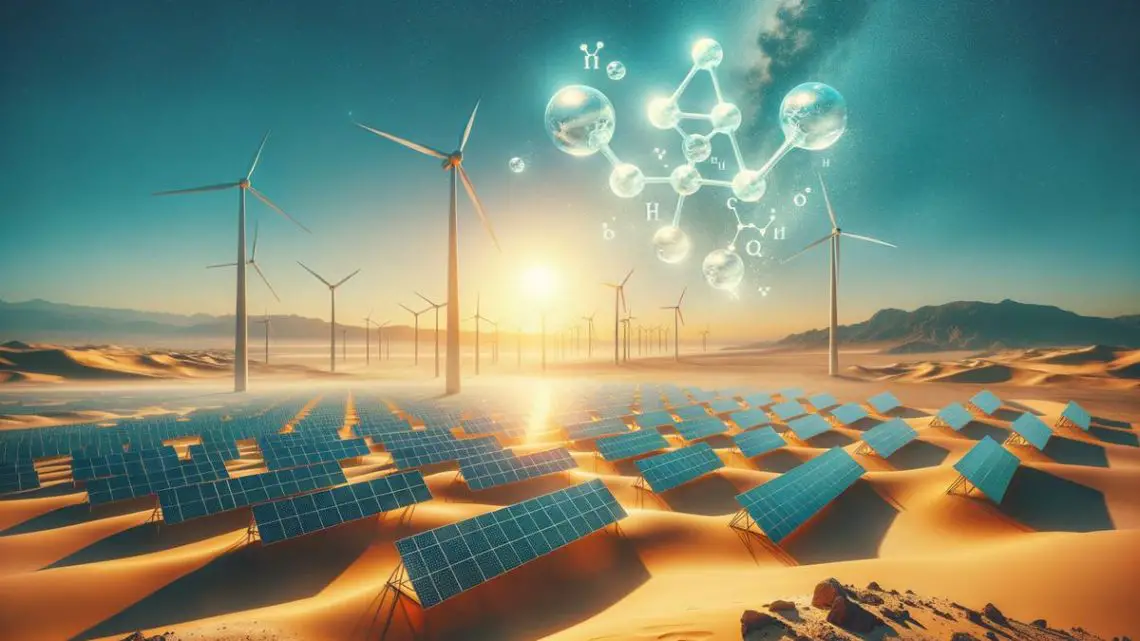
Industry Insight on Egypt – Emerging Power in Green Hydrogen
March 6, 2024Egypt stands poised at a pivotal moment, leveraging its geographical and technological strengths to forge a path forward in the green hydrogen sector. With its bountiful resources and strategic position, the country aims to cement its place as a leader in the clean energy transition. This ambition sets the stage for a detailed exploration of the opportunities and challenges that lie ahead, each aspect contributing to the blueprint of a sustainable energy future.
Egypt’s Geographic Advantages in Green Hydrogen Development
Egypt’s Strategic Location
Egypt stands at the crossroads of Africa and the Middle East, bordering the Mediterranean and the Red Seas. This strategic positioning is key in the development and export of green hydrogen. It provides Egypt with direct access to European and Asian markets, making the transportation of hydrogen less complicated and more cost-effective. The proximity to these markets is crucial as demand for green hydrogen – a cleaner energy alternative – grows globally.
High Solar and Wind Potential
A significant factor in the production of green hydrogen is the availability of renewable energy sources like solar and wind power. Egypt is favored with high solar irradiance and strong, consistent wind speeds, particularly in areas like the Gulf of Suez. These renewable energy resources are essential for the electrolysis process – splitting water into hydrogen and oxygen using electricity derived from renewable sources. The abundance of sun and wind not only ensures a steady supply of green electricity but also positions Egypt as a capable producer of green hydrogen at a competitive cost.
Vast, Unused Landscapes
For green hydrogen production to be viable, substantial land is required for the installation of solar panels and wind turbines. Egypt’s geography includes vast deserts and uninhabited land areas that are perfect for setting up large-scale renewable energy projects. These lands, which are otherwise unproductive for agriculture or urban development, offer a unique opportunity to host infrastructure for both renewable energy production and green hydrogen manufacturing facilities.
Existing Energy Infrastructure
Egypt is not new to the energy sector; it has a long history of oil and gas production. This background provides an existing framework of energy infrastructure and a skilled workforce that can be transitioned into the green hydrogen sector. Adapting current pipelines, ports, and other facilities to accommodate green hydrogen production and export is more efficient than starting from scratch, offering a faster route to market.
Government Commitment
The Egyptian government, recognizing its geographic and strategic benefits, has exhibited a robust commitment to bolster its green hydrogen prowess. It is actively formulating policies and establishing partnerships with international energy corporations, with the aim of transforming Egypt into a nexus for green hydrogen production. This governmental backing is vital in offering a consistent regulatory atmosphere and drawing investment into the sector. Moreover, the government has set an ambitious national target to escalate its renewable energy resources from 3.1GW in 2020 to a substantial 13.2GW by 2030.
Water Availability
While green hydrogen production is water-intensive, Egypt’s strategic projects like desalination plants and the reuse of agricultural water can help mitigate these needs. Efficient water management strategies are essential in ensuring a sustainable supply of water for green hydrogen production without compromising the country’s water security.

Regulatory Framework and Government Support
Legislation plays a significant role in setting the stage for green hydrogen initiatives. By establishing a coherent set of rules and guidelines, Egypt aims to reduce the uncertainties that often accompany novel technologies and markets. This legislative groundwork is essential for attracting investment, as it provides a degree of predictability and security that investors seek.
Consents and permits are one area where Egypt’s regulatory environment is taking shape. The government is working on simplifying the process to obtain the necessary approvals for green hydrogen projects. This involves creating clear pathways for obtaining environmental and operational permits, ensuring project developers understand what is required from the outset. Such clarity is not only about adherence to regulations but also about safeguarding the surrounding environment and communities, aligning with broader sustainability goals.
Furthermore, Egypt is keen on integrating local content requirements within its green hydrogen regulatory framework. This approach ensures that the benefits of green hydrogen projects extend to the local economy, fostering job creation and skill development within the nation. It underscores the government’s vision of not just developing a green hydrogen sector but doing so in a way that contributes to broader economic development.
The government is also mindful of the potential for regulatory adjustments and is striving for a balance between flexibility and stability. As the green hydrogen sector evolves, so too might the regulatory needs. Egypt is preparing for this eventuality, aiming to craft a regulatory environment that can adapt to technological advancements and market shifts without compromising project certainty or investor confidence.
In tackling the challenges of regulatory framework development, Egypt is not acting in isolation. International collaborations and consultations are part of the strategy, recognizing the global nature of the green hydrogen market. Engaging with international experts and aligning with global best practices helps ensure that Egypt’s regulatory framework is robust, competitive, and capable of supporting a thriving green hydrogen sector.

Egypt’s Role in International Green Hydrogen Markets
Egypt is rapidly carving out its role in the international green hydrogen landscape, leveraging its unique geographic and strategic advantages. Recent headlines attest to this, highlighting significant advances in the sector with a slew of new projects and partnerships.
Among these is a landmark project that could potentially revolutionize Egypt’s renewable energy sector. Two companies, SK Ecoplant, a leading environmental and energy company, has joined forces with China State Construction Engineering Corp (CSCEC), China’s largest state-owned construction company, to launch a groundbreaking $1.9 billion green hydrogen project in Egypt. They are collaborating to establish a renewable energy power plant with a formidable capacity of 778 MW, which includes 500 MW of solar power and 278 MW of onshore wind power. The power generated at this facility will be used to extract green hydrogen from water using 250 MW water electrolyzers, including the Bloom Energy SOEC (solid oxide water electrolyzer).
This green hydrogen will then be transformed into green ammonia, a substance that is easier to store and transport, making it an excellent export product. The project aims to produce approximately 50,000 tons of green hydrogen and about 250,000 tons of green ammonia annually. Commercial operations are projected to commence by the end of 2029, with the total project cost estimated at around 2.6 trillion won.
This agreement signifies a crucial step forward, with both companies set to receive site designations from the Egyptian government and begin a joint feasibility study. Based on the study’s outcome, they plan to finalize the project’s specific scale and schedule.
Enhancing Technological Capabilities
For Egypt to realize its green hydrogen potential, advancing and adopting cutting-edge technologies is non-negotiable. The country needs to focus on improving electrolysis technologies—the process of using electricity to split water into hydrogen and oxygen. This is particularly crucial because the efficiency of this technology directly impacts the cost and feasibility of producing green hydrogen. By fostering collaborations with global tech leaders and investing in research and development, Egypt can improve its technological baseline, thus reducing production costs and enhancing its competitive edge in the green hydrogen market.
Market Dynamics and Pricing Strategies
Understanding and adapting to global market dynamics is another critical factor for Egypt. The global demand for green hydrogen is expected to soar, driven by the need to decarbonize sectors like transportation, industry, and power generation. However, Egypt must navigate the pricing strategies smartly. Since green hydrogen production is currently more expensive than traditional hydrogen production methods, the challenge lies in scaling up production and reducing costs without compromising on sustainability commitments. Implementing strategies like tax incentives for green hydrogen initiatives, or subsidizing renewable energy sources can assist in making green hydrogen a more economically viable product for both domestic use and export.
Exploiting International Cooperation
International cooperation is indispensable for Egypt’s green hydrogen ambitions. Partnerships with countries and companies that have advanced green technologies can provide Egypt with the necessary technological, financial, and regulatory support. These collaborations can also help Egypt tap into new markets, ensuring a steady demand for its green hydrogen. Moreover, by actively participating in global green hydrogen initiatives, Egypt can shape international strategies and standards, ensuring they align with its interests and capabilities.
Aligning with Environmental and Social Goals
While developing its green hydrogen sector, Egypt must ensure that its strategies align with broader environmental and social goals. This includes not just reducing carbon emissions but also promoting job creation, social inclusion, and sustainable economic growth. The development of the green hydrogen sector should be integrated into Egypt’s wider climate action plans, ensuring that it contributes to the country’s targets under international agreements like the Paris Agreement.

Challenges and Risks Facing Egypt’s Green Hydrogen Ambitions
As Egypt sets its sights on becoming a leader in the green hydrogen market, several challenges and risks must be addressed to ensure the nation’s success. Despite its advantageous geographical position and government initiatives, Egypt faces technological, market, and cooperation hurdles that could potentially impede its green hydrogen advancement.
Technological Advancements and Capacity
A primary concern is the current state of technological capabilities within Egypt. For the country to lead in green hydrogen, it is essential to possess not only the basic technology for hydrogen production but also advanced techniques that increase efficiency, reduce costs, and ensure sustainability. Developing or acquiring such technology requires significant investment, training, and research. Without a robust framework for fostering technological innovation and capacity-building, Egypt risks falling behind nations that are investing heavily in these areas.
Understanding Market Forces
Another challenge lies in navigating the complex dynamics of the global green hydrogen market. Pricing strategies are critical, as Egypt must find a balance between being competitive on the international stage and ensuring the economic viability of its green hydrogen sector. This involves understanding and reacting to market demands, price fluctuations, and the cost implications of technological choices. Furthermore, building a green hydrogen economy is not only about production but also about creating demand – both domestically and internationally. Egypt needs to cultivate industries and partners that require green hydrogen, necessitating strategic market analysis and engagement.
Leveraging International Cooperation
While Egypt has engaged in international collaborations, maximizing the benefits from such partnerships remains a challenge. Effective cooperation goes beyond investment deals, encompassing technology transfer, capacity building, and shared standards for production and trade. The country must navigate geopolitical and economic considerations, ensuring that international partnerships are mutually beneficial and aligned with its green hydrogen goals. Additionally, Egypt’s role in international forums and its ability to influence global regulatory standards for green hydrogen will be important for its success in this sector.
Environmental and Social Considerations
Aligning green hydrogen production with environmental and social goals is crucial for sustainable development. This alignment includes ensuring that green hydrogen projects do not adversely affect local communities or ecosystems. Challenges such as water usage, land rights, and biodiversity must be addressed, requiring comprehensive environmental assessments and community engagement strategies. Moreover, integrating green hydrogen projects with local economic development plans can help in securing public support and creating value for Egyptian society at large.
Charting the Path Forward
In conclusion, Egypt’s journey to becoming a green hydrogen leader involves navigating a landscape marked by technological, market, and cooperative challenges. Additionally, aligning the sector with environmental and social goals is non-negotiable for sustainable progress. Addressing these challenges requires a holistic approach, combining policy measures, strategic investments, and an inclusive vision that encompasses both the economic and societal dimensions of green hydrogen production. While the road may be fraught with hurdles, Egypt’s commitment to overcoming these challenges can pave the way for it to become a key player in the global green hydrogen economy.

The strides Egypt makes in the green hydrogen realm have the potential to not only transform its own energy landscape but also to influence global energy markets and sustainability practices. Just within the last few years, Egypt has positioned itself as a hub for green hydrogen projects worldwide. Capitalizing on its abundant renewable energy potential, it aims to produce green hydrogen more cost-effectively than other regions.
Over 20 such projects are already in progress, backed by the government’s comprehensive support and goal of capturing 5% of the global hydrogen market by 2040. Egypt’s unique geographic advantages, vast renewable energy resources, expansive infrastructure space, existing energy framework, government backing, and innovative water management strategies collectively provide a fertile ground for its ambitions in the green hydrogen sector. These factors poise Egypt to be a key player in the global shift towards cleaner energy sources.
In essence, Egypt’s green hydrogen sector, though in its embryonic stage, is marked by a clear trajectory of growth, backed by strategic advantages, government support and international collaboration. As the sector evolves, it holds the promise of propelling Egypt to the forefront of global green energy transitions, embodying a blend of innovation, sustainability and economic opportunity.



 HFN News is your leading source for fresh hydrogen and renewable energy updates. Amid the fast-paced growth of hydrogen companies, we provide top-notch news and insights about this exciting sector. Our coverage spans from hydrogen cars to global sustainable initiatives, and we highlight the latest in green jobs and developing hydrogen hubs. We invite you to share your local hydrogen news and explore today’s renewable energy job listings on our site. Thanks for choosing HFN News as your trusted guide to the hydrogen and renewable energy world!
HFN News is your leading source for fresh hydrogen and renewable energy updates. Amid the fast-paced growth of hydrogen companies, we provide top-notch news and insights about this exciting sector. Our coverage spans from hydrogen cars to global sustainable initiatives, and we highlight the latest in green jobs and developing hydrogen hubs. We invite you to share your local hydrogen news and explore today’s renewable energy job listings on our site. Thanks for choosing HFN News as your trusted guide to the hydrogen and renewable energy world!